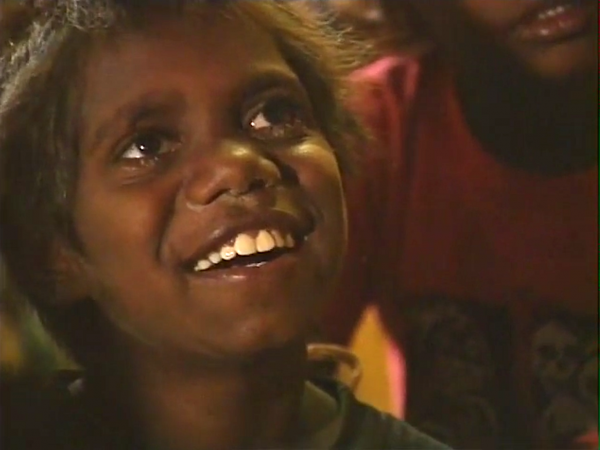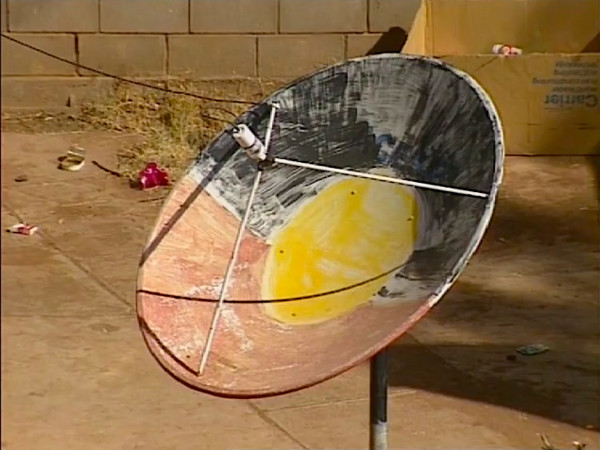
8. Yuendumu: Warlpiri TV, BRACS & the Tanami Network
Warlpiri Media Association
We’ve got ABC and Imparja, and plus our local one. Mainly they like the local one, like they want to hear themselves and look at themselves. Sometimes there’s little bit of jealousy on television, when people talk, ‘Oh I could have talked like that, I’m going to talk next time, so that they can listen to me’.
(on Warlpiri News)
Good afternoon, welcome to the news from Warlpiri Media. As you know there are problems in the community, between the people working at the clinic and the health mob. The bosses came from town to talk…That’s all I have to say to you from Warlpiri Media – goodnight.
The Warlpiri Media Association has been producing video programmes for the last 8 years. Their first video broadcasts were transmitted illegally over a pirate transmitter. Today their news is broadcast daily to the local community. Along with 74 Aboriginal Communities, Yuendumu has its own Government supplied BRACS system. Modelled on the early illegal experiments, is the Broadcasing in Remote Aoboriginal Communities Scheme, which not only enables communities to receive ABC and Imparja off the satellite, but also to substitute them with their own programming.
We use our local TV to show dreamtime stories…told by old men, or for custodians to teach about the land. That’s why we make our own television.
I’m not talking about white fellah news, just about Aboriginal dreaming.
Freda Glynn
Well I think that BRACS certainly is a good idea. The way that I saw them doing it, as being gatekeepers to the media that’s coming into their communities, and allowing them to switch into the programmes they thought most beneficial to the community, as well as being able to put their own little news service on daily, or what the children were doing at school that day, or what community meetings were happening, happened that day.
BRACS Adviser
Of course, the impetus for all of that started at Yuendumu, when Yuendumu decided to set up their ‘illegal’ broadcasting, and one of the people who was in the early stages of that process at Yuendumu, was Chris Poulson. And the way Chris has always described the situation is that he’s seen the danger of television from outside bringing, being a powerful cultural force that would destroy what was there.
So he saw BRACS like a shield, he saw that BRACS was out there like a traditional Aboriginal shield, stopping the spears that were coming from outer space, if you like, from the satellites. And the programmes that the community would be making – like they were at Yuendumu – those programmes would be the spears going back again, from behind the shield… 74 communities were chosen by the Government, and 74 communities suddenly had BRACS in their midst. That was a long way from the original idea of the communities themselves choosing it…
None of us.. the people like, other communities don’t know how to use it, because there was no training for it…
Co-ordinator, EVTV
The problem is, perhaps, that the equipment has gone in without necessarily communities having the sort of experience or media policies in place we’ve had here. We for example, broadcast for a full year before we got a satellite dish ourselves with our own money, and broadcast local programme mixed with video footage sent up from Adelaide to get the community used to that concept. And we had 4 hours broadcast a night, of which 1 hour was in Pitjantjatjara.
Where there was neither an interest on behalf of somebody in the community, nor any training, the equipment simply sits in a room, is switched on to Imparja, the commercial channel or ABC Television and left to run - and it’s just then a filter, a sponge, sucking up what the satellite has to offer and spreading it out around the community.
Principal, Yuendumu School
Right from the start, right from 1986 and ever since, we’ve been saying ‘Well it’s pointless putting a whole lot of shiny equipment in a room, and saying you’ve established community broadcasting. The core of the process is people, and the commitment of the Aboriginal people to the concept and to the activity’.
In that BRACS gear, I have to run around because the Government never gave us funding for that. Because I have to do it for my own time, and the other communities, they pay me a little bit for doing that. Like Mount Allan had a problem with BRACS. They thought a wire broke down, but that was a redback spider, was sitting on it. So every time they watch it [in] daytime it was blocked, and night-time they used to watch it because the spider went out to get a feed!
We get all sorts of funny jobs put out at places like this, but the one job that I would put above all else is in communication, because communication is so much at the core of communities and Aboriginal culture.
The Warlpiri Media Association is planning to link the BRACS system on the Warlpiri lands, using compressed video – a cheap way of sending TV pictures via satellite.
If there was a major political meeting that was on an issue that affected all communities, such as the health meeting that we had today, that could also be broadcast right around so that people are not only aware of what’s going on in their own community, but getting a line on what other people are thinking in other communities. I think that would empower people considerably out in the bush.
Film-maker
One of the original concerns was that ‘OK, people out there are going to get bombarded by all the soapies and all the rubbish culture…
I think people have a right to pick and choose of our culture what they want - and I don’t see them as necessarily being destructive, because I think that people are going to choose from the modern world what they like from it, and they’ll keep from their own world what they like of that.

